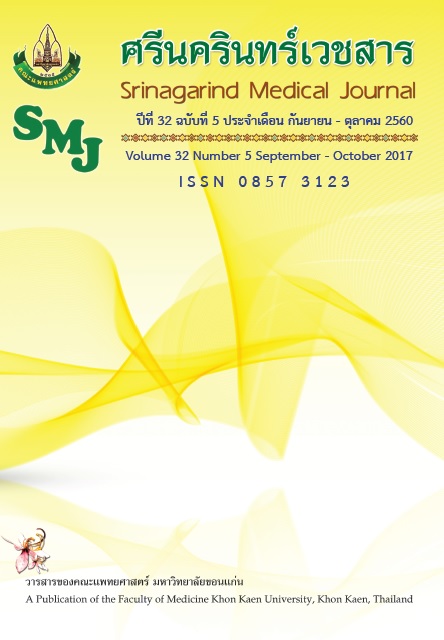A Comparison of Laryngeal Mask Airway Cuff Inflation Technique Between Current Practice and Manometer for Proper Intra-Cuff Pressures: A Randomized Control Trial
Keywords:
dysphagia, hoarseness, intracuff pressure, Laryngeal Mask Airway, LMA, manometer, sore throat, กลืนลำบาก, ค่าความดันใน cuff, เจ็บคอ, หน้ากากครอบกล่องเสียง, เสียงแหบAbstract
Background and Objective : The current trend of using Laryngeal mask airway (LMA) for airway maintenance during inhalational anesthesia is increasing due to ease to use, avoid muscle relaxant and laryngoscopy,less stimulate the sympathetic system than endotracheal tube insertion. However, there are several complications such as sore throat, hoarseness and dysphagia, which is related to the LMA intra-cuff pressure above the recommended level of 60 cmH2O. In current practice, the volume of cuff inflation is following the manufacturer's recommendations without measuring the LMA intracuff pressure. The aim of this study was to compare the methods to obtain proper LMA intracuff pressure and volume.
Materials and Methods : This was a prospective randomized control trial ninety patients ASA status 1-3 undergo surgery under inhalational anesthesia with LMA ProSealTM were randomized into two groups; 1) control group which the patients were inflated LMA cuff according to routine care and 2) Manometer group which the patients were inflated LMA cuff using a Hi-Lo Pressure Gauge ShileyTM manometer .Both group were measured cuff pressure and volume by using a manometer and evaluated the leakage and expiratory tidal volume until the end of surgery then follow up for complications up to the first day of surgery.
Result: Patients were randomized into 2 groups of 45 patients. The mean of LMA intra-cuff pressure of control group was higher than manometer group (80.4土2.7 and 86.9土3.2 vs 60 cmH2O for LMA No3 and 4 respectively ; p<0.01 ). The cuff inflation volume of manometer group was lower than control group(LMA No.3 was17.9vs 20, mL,LMA No.4 26.5vs 30 ml which was 89土2 and 88土2% of the control group respectively) There was no difference of efficacy of airway maintenance during anesthesia in different LMA intracuff pressure level of 60,50 and 40 cmH2O ,however LMA intracuff volume was reduced (LMA No.3 ;17.9,16.6 and 15.4 ml, or 89, 88 and 77 % of recommended values respectively, LMA No. 4; 26.5,24.7 and 22.7 ml or 88, 82 and 76 % of recommended value, respectively) and postoperative complications such as sore throat, hoarseness and dysphagia was not difference between groups.
Conclusion: Current practice in LMA ProSealTM cuff inflation results in intracuff pressure exceeding the appropriate limit. For the best practice is using the manometer guiding cuff inflation but for limited resource appropriate volume should be about 15 and 22 ml. for LMA No.3 and 4 respectively or 80% of the recommended value of both LMA size
การศึกษาเปรียบเทียบวิธีการเติมอากาศในกระเปาะของหน้ากากครอบกล่องเสียงระหว่างเวชปฏิบัติปัจจุบันกับการใช้เครื่องวัดแรงดันเพื่อให้ได้ระดับแรงดันในกระเปาะที่เหมาะสม: การทดลองแบบสุ่มและมีกลุ่มควบคุม
หทัยระวี ห้าวหาญ
กลุ่มงานวิสัญญี โรงพยาบาลอุดรธานี จ.อุดรธานี 41000
หลักการและวัตถุประสงค์ : ปัจจุบันมีการใช้งานหน้ากากครอบกล่องเสียง (Laryngeal Mask Airway: LMA ) เพื่อควบคุมทางเดินหายใจระหว่างการดมยาสลบมากขึ้นเนื่องจากง่ายต่อการใช้งาน หลีกเลี่ยงการใช้ยาหย่อนกล้ามเนื้อและ laryngoscope มีผลกระตุ้นความดันโลหิตและระดับ norepinephrineในพลาสมาน้อยกว่าการใส่ท่อช่วยหายใจแต่ในขณะเดียวกันก็มีภาวะแทรกซ้อนคือเจ็บคอ เสียงแหบและกลืนลำบากซึ่งพบว่าสัมพันธ์กับ LMA intracuff pressure ที่สูงเกินค่าที่แนะนำคือไม่เกิน 60 ซม.น้ำ ในเวชปฏิบัติปัจจุบันปริมาตรอากาศที่เติม LMA cuff ในนั้นจะเป็นไปตามคำแนะนำจากบริษัทผู้ผลิตโดยไม่มีการวัด intracuff pressure ที่แท้จริง วัตถุประสงค์ของการศึกษานี้เพื่อเปรียบเทียบ LMA intracuff pressure และ LMA intracuff volume ที่เกิดจากวิธีการเติมอากาศใน cuff ของ LMA (ProSealTM ) ที่ปฏิบัติอยู่ในปัจจุบันกับการเติมอากาศแบบใช้เครื่องวัดแรงดัน (Hi-Lo Pressure gauge ShileyTM )เพื่อให้ได้ LMA intra-cuff pressure ที่เหมาะสม
วิธีการศึกษา : เป็นการศึกษาแบบไปข้างหน้าแบบสุ่มและมีกลุ่มควบคุม ผู้ป่วยในการศึกษาจำนวน 90 ราย ASA status 1-3ได้รับการดมยาสลบด้วยเทคนิค inhalational anesthesia และใส่ LMA ProSealTM ได้ถูกแบ่งออกเป็น 2 กลุ่มคือ 1) ผู้ป่วยที่ได้รับการเติมอากาศตามเวชปฏิบัติปัจจุบัน 2) ผู้ป่วยที่ได้รับการเติมอากาศใน LMA cuff โดยใช้ manometer Hi-Lo Pressure gauge Shiley TM ทั้งสองกลุ่มจะถูกบันทึก LMA intracuff pressure และ intracuff volume ที่ใช้ กลุ่มทดลองจะถูกเติมอากาศโดยใช้ manometer เพื่อให้ได้ LMA intracuff pressure เท่ากับ 60,50 และ 40 ซม.น้ำ ตามลำดับร่วมกับวัด LMA intracuff volume และประเมินประสิทธิภาพการควบคุมทางเดินหายใจในทุกระดับ LMA intracuff pressure ทั้งสองกลุ่มจะถูกติดตามภาวะแทรกซ้อนไปจนถึง 24 ชั่วโมงหลังผ่าตัด
ผลการศึกษา : ผู้ป่วยทั้งหมด 90 รายถูกสุ่มออกเป็น2กลุ่มกลุ่มละ 45 ราย ค่าเฉลี่ยของ LMA intracuff pressure ทั้ง 2 กลุ่มมีความแตกต่างกันอย่างมีนัยสำคัญทางสถิติได้แก่ 80.4土2.7 และ 86.9土3.2 เปรียบเทียบกับ 60 ซม.น้ำสำหรับ LMA เบอร์ 3 และ 4 ตามลำดับ (p<0.01) เมื่อเปรียบเทียบ LMA intracuff volume พบว่าในกลุ่มควบคุมใช้ปริมาตรอากาศมากกว่ากลุ่มทดลอง (LMA เบอร์ 3; 20 เปรียบเทียบกับ 17.9 มล. ซึ่งคิดเป็นร้อยละ89土2 ของกลุ่มควบคุม LMA เบอร์ 4; 30 เปรียบเทียบกับ 26.5 มล.ซึ่งคิดเป็นร้อยละ 88土2 ของกลุ่มควบคุม (p<0.01) เมื่อเปรียบเทียบประสิทธิภาพการควบคุมทางเดินหายใจที่ LMA intracuff pressure 60 50 และ 40 ซม.น้ำ ในกลุ่มทดลองพบว่าไม่มีความแตกต่างกันอย่างมีนัยสำคัญทางสถิติ แต่ intracuff volume ลดลง (LMA เบอร์ 3; 17.9 16.6 และ 15.4 มล. หรือคิดเป็นร้อยละ 89 88 และ77 ของค่าแนะนำตามลำดับ LMA เบอร์ 4; 26.5 24.7 และ 22.7 มล. หรือคิดเป็นร้อยละ 88 82 และ 76 ของค่าแนะนำตามลำดับ) ภาวะแทรกซ้อนหลังดมยาสลบได้แก่ เจ็บคอ เสียงแหบและกลืนลำบากพบว่าไม่มีความแตกต่างกันทั้งสองกลุ่ม
สรุป : การเติมอากาศในกระเปาะของ LMA ProSealTM ตามที่ปฏิบัติในปัจจุบันนั้นมีผลทำให้ LMA intracuff pressure สูงเกินค่าที่เหมาะสม การใช้ manometer จะทำให้ได้ LMA intracuff pressure ที่เหมาะสมที่สุดแต่ในบริบทที่จำกัดสามารถเติมอากาศด้วยปริมาตร15 และ22 มล.โดยประมาณสำหรับLMAเบอร์3และ4 ตามลำดับหรือประมาณร้อยละ80 ของค่าแนะนำก็สามารถหลีกเลี่ยงไม่ให้ LMA intracuff pressure สูงเกินค่าที่เหมาะสมได้




